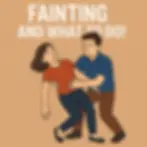Fainting and what to do.
- Jason T
- Jun 26
- 4 min read
Updated: Jul 1

Sudden Medical Emergencies: Part 1 – Fainting (Syncope)
A Guide for Nursing Students
As a nursing student, you’re preparing to be on the front lines of healthcare—whether at the bedside, in clinics, or out in the community. One of the most common and sudden emergencies you may encounter is fainting, also known medically as syncope. Understanding the signs, causes, and correct interventions can help you make a real difference in a crisis.
What Is Fainting?
Fainting is a temporary loss of consciousness that occurs when blood flow to the brain drops suddenly, often due to a drop in blood pressure. It typically lasts only a few seconds to minutes, but it can be alarming—especially in a fast-paced healthcare setting.
You may hear it called:
Fainting
Passing out
Blacking out
Syncope (Medical Term)
Recognizing the early warning signs—such as dizziness, nausea, tunnel vision, or sweating—can help prevent the situation from escalating.
💡 A Quick Laugh: Fainting Goats—Nature’s Drama Queens
Now, while human fainting is a serious matter, let’s take a moment to appreciate nature’s most unintentionally hilarious animals: the fainting goat. These adorable creatures don’t actually pass out—they just look like they do. Due to a genetic condition called myotonia congenita, when they’re startled, their muscles stiffen up, and down they go—legs out like a cartoon character slipping on a banana peel. Unlike humans, these goats usually bounce right back up and carry on with their day like nothing happened. It’s a funny reminder that while fainting in people requires a first aid response, sometimes Mother Nature just likes to keep things interesting.
Check out this short clip for a guaranteed laugh… and don’t worry, no goats were harmed in the making!
Common Causes of Syncope in Patients
As a future healthcare professional, it’s important to recognize triggers that might cause someone to faint:
Pregnancy
Standing or sitting in one position too long
Pain or sudden trauma
Emotional stress or traumatic imagery
Excessive heat or overheating
Dehydration
Low blood sugar or poor nutrition
Prevention Tips for Nursing Students & Patient Education
Preventing syncope isn’t always possible—but being aware of risk factors and early symptoms helps you act quickly.
✅ Encourage hydration and regular meals
✅ Educate patients to rise slowly from lying or sitting
✅ Loosen restrictive clothing, especially around the neck
✅ Watch for dizziness, pale skin, nausea, or weakness
In clinical settings, your quick assessment and calm presence can make all the difference.
First Aid Response: What to Do When Someone Faints
As a trained responder—or soon to be—here’s how to manage fainting episodes safely and effectively:
Step 1: Scene Safety and Initial Assessment
Ensure the area is safe before approaching
Check responsiveness, then assess Airway, Breathing, and Circulation (ABCs)
Use gloves if bodily fluids are present
Step 2: Call for Help
Call 911 immediately if:
You're alone
The fainting is related to a fall, head, neck, or spinal injury
It occurs during a motor vehicle accident or in a hazardous environment
The patient is pregnant or has a history of cardiac conditions
Step 3: Provide Care
If there are no immediate life-threatening injuries, place the person in the recovery position to promote circulation and protect the airway—especially if medical help is delayed.
Important: Do not move the person if spinal, head, or neck injury is suspected.
How to Perform the Recovery Position (Step-by-Step)
Kneel beside the person.
Move the far arm up and place it next to their head.
Place the near arm across the chest (like a seatbelt).
Bend the knee closest to you.
Support the head and neck using your hand in the hollow of the neck.
With the other hand, push the bent knee and shoulder gently to roll them onto their side.
Adjust the limbs so the position is stable. Ensure the airway is open and the person is breathing.
When to Seek Medical Attention
Fainting can be harmless—but medical follow-up is essential, especially if the patient:
Is pregnant
Has a cardiac history
Has ongoing symptoms like chest pain, confusion, or irregular breathing
Final Thoughts for Nursing Students
As future nurses, your knowledge and confidence matter in high-pressure moments. Fainting may seem minor, but it could be the first warning sign of a more serious condition. Stay alert, trust your training, and always prioritize safety—for your patient and yourself.
📚 This post is based on guidance from: The Canadian Red Cross, Alberta Health Services, and the Heart & Stroke Foundation of Canada.
🛑 Disclaimer: This blog is for informational purposes only and is not a substitute for formal training or medical advice. Please consult your instructor, physician, or certified safety trainer for proper instruction.
Ready to Get Certified?
Be prepared. Be confident. Learn First Aid Today & Save a Life Tomorrow with Saving Grace Medical Academy Ltd. Now enrolling: Basic Life Support (BLS) & Standard First Aid CPR-C & AED courses designed for healthcare professionals.
📍 Training for First-Year Nursing Students
Join Saving Grace Medical Academy Ltd. for fully certified, CSA-compliant Standard First Aid CPR-C & AED courses—designed for Alberta’s future healthcare professionals.
Just Remember:
Protect Yourself. Call 911.Don’t Waste Time.
RESOURCES:

Author - Saving Grace Medical Academy Ltd
Jason T
Retired EMT - Heart & Stroke Foundation Senior Instructor




